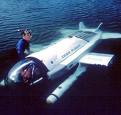|
Deep Flight-I
 Hawkes Ocean Technologies (HOT) was founded as a skunk works in 1996 by world-renowned engineer Graham Hawkes to design and build revolutionary subsea vehicles. The six-person design and engineering team operates out of a garage workshop on San Francisco Bay. Hawkes Ocean Technologies (HOT) was founded as a skunk works in 1996 by world-renowned engineer Graham Hawkes to design and build revolutionary subsea vehicles. The six-person design and engineering team operates out of a garage workshop on San Francisco Bay.
Deep Flight I (DF- I) is the prototype first stage in an attempt to navigate to the deepest reaches of the ocean and represents a radical new design approach for underwater vehicles. Instead of using a traditional ballast system to control dive and ascent, DF-I uses stubby inverted wings to provide "negative" lift that pulls the small sub down. This downward force negates the slightly buoyant characteristics of the sub. At cruising speeds the sub is neutrally buoyant and depends on its thrusters to drive the sub up or down, the same principle used in airplanes. While traditional ballast systems emulate airships and hot air balloons, this principle, along with DF-I`s small size, allows the pilot to descend at a very fast rate to maximize bottom time. Since the overall aim is to get to 37,000 ft, it is critical to get to the bottom as quickly as possible to ensure the longest exploration time.
DF-I serves as the technology bridge to the next generation of deep ocean work craft, launched in September 1996 from the Monterey Bay Aquarium in Monterey, California. Deep Flight has been featured in many primetime television programs, including Dateline NBC and National Geographic Explorer.
Technical specifications, Deep Flight I (DF-I):
This streamlined craft sporting stubby wings, tail fins, and rudder, can perform hydroacrobatics, barrel rolling, dive bombing, breaching, while soaring in the deep blue. This sort of underwater maneuverability has previously been restricted to dolphins and whales.
Weight in air (lb/kg): 2,860/1,300
Payload in air (kg): un known
Dimensions (L*W*H feet/meter): 13`0*8`0*3`0/3.95*2.45*0.92
Propulsion: un known
Speed (sub/knots): 4-8 cruise, 12 max (estimated)
Range (sub n/miles@knots): 1-4 hours operational time
Diving depth (feet/meter): 3,000/900
Complement: 1 pilot prone position
Construction: Glass/Epoxy composite (main structure)
Back to History Index
 |
Turks and Caicos Is. |
1997 |
1996.Deep Flight-I.Revolutionary one-man research vesel (DSV) |
|